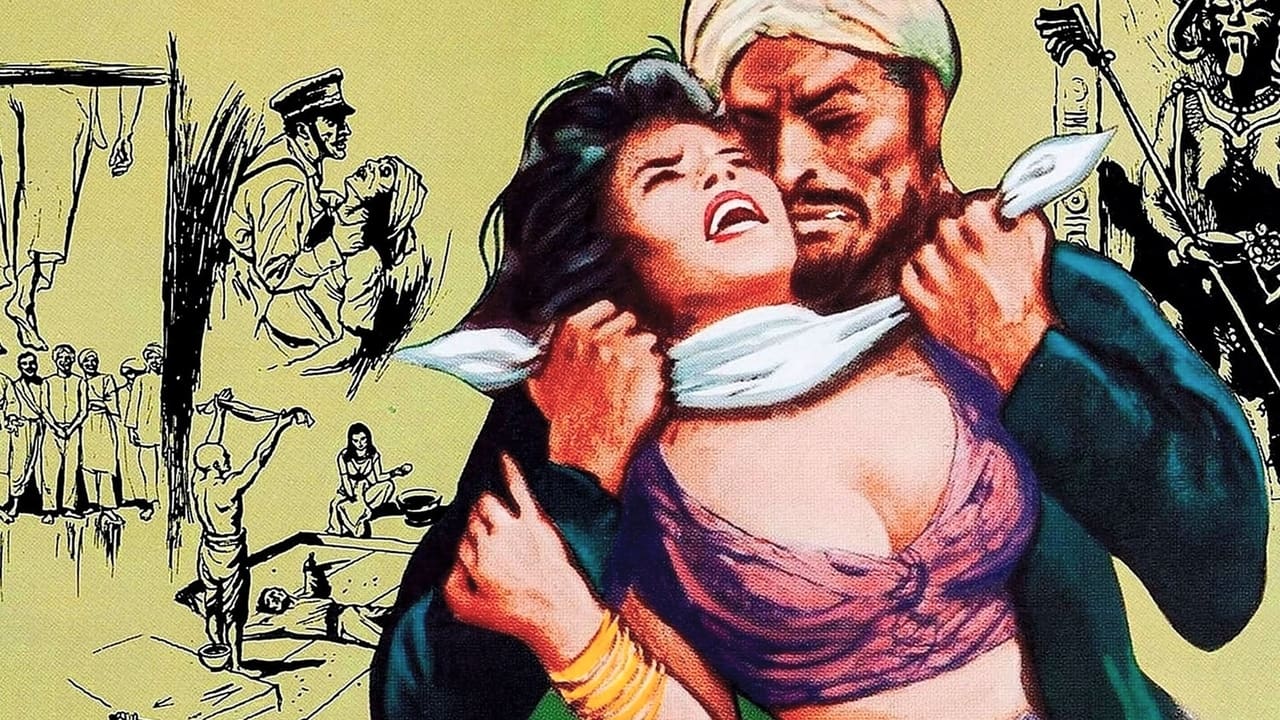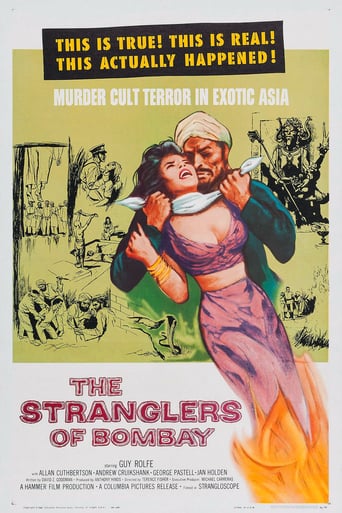

An absolute waste of money
... View MoreIt's hard to see any effort in the film. There's no comedy to speak of, no real drama and, worst of all.
... View MoreThere's a more than satisfactory amount of boom-boom in the movie's trim running time.
... View MoreGreat movie. Not sure what people expected but I found it highly entertaining.
... View MoreIn 19th Century India, a vicious cult dubbed the Thuggees is terrorizing their own countrymen, robbing and killing with impunity. Harry Lewis (Guy Rolfe), a captain with the East India Company, knows that there's a problem. He's noted the mass disappearances of citizens over time, but his superior officer (Andrew Cruickshank) doesn't take him seriously. Harry gets personally involved when his faithful servant, Ram Das (Tutte Lemkow), goes missing while in search of his brother.Hammer stalwart Terence Fisher directs with his customary efficiency. Fisher keeps the entertaining story moving along nicely, taking advantage of the exotic setting and creating some truly wonderful atmosphere. Many of the popular Hammer talents strut their stuff, including the cinematographer, Arthur Grant, who shoots "The Stranglers of Bombay" in beautiful widescreen black & white. Bernard Robinson also works wonders with the production design. Written by David Zelag Goodman ("Straw Dogs", "Logan's Run", "Eyes of Laura Mars"), this is a reasonably absorbing adventure. Some viewers might take offence at the portrayal of the Thuggee cult (just as people did when "Indiana Jones and the Temple of Doom" came along 25 years later). But the suspense is undeniable at times and it's cute to see a mongoose play a part in the action when Lewis's life is threatened by a cobra. It's a truly chilling moment when Ram Das is murdered in cold blood by someone close to him.Excellent performances are a real plus. Rolfe is a highly engaging hero, and among the other Hammer repertory players here, George Pastell shines. Pastell has one of his most substantial roles as the villainous High Priest of Kali. Allan Cuthbertson is amusing as the arrogant, ineffective Captain Connaught-Smith. Marne Maitland, Paul Stassino, Roger Delgado, John Harvey, Warren Mitchell, Michael Nightingale, Ewen Solon, and David Spenser all do fine jobs in their respective roles.Some viewers may also be put off by the rather vivid violence, but this film still sizes up as an agreeable diversion for Hammer fans.Seven out of 10.
... View MoreA classic and sorely underrated Hammer film in which the British East India Company officer Captain Harry Lewis - played very well by the engaging Guy Rolfe whom I recognise from something else but can't remember what - fights the cult of Kali which is responsible for the kidnapping and murder of thousands of Indians. The film has a very strong and effectively creepy and violent storyline and is directed to perfection, as ever, by Terence Fisher.Unlike most Hammer films, it is based on real events though I don't know how closely as it's well outside my historical area of interest. One historical aspect of the film that I appreciated was Lewis' criticism of the East India Company, which he points out to his superior Colonel Henderson (a wonderful Andrew Cruickshank) is not investigating the disappearances of several thousand Indians out of any sense of morality or responsibility but because it is related to the disappearance of several English merchants' caravans. Another very effective piece of social commentary is Henderson giving the job of investigating the disappearances not to Lewis, the logical and seemingly obvious choice given that he has spent two years doing so on his own initiative, but to the supercilious and not very bright Captain Connaught-Smith (played, again very well, by Allan Cuthbertson) whose father went to school with Henderson. Shari Patel described Connaught-Smith very well in the film: "Captain Connaught-Smith is pleased by the obvious. It does not exercise his dull mind." The treatment of the Indians in the film is far less condescending and insulting than the treatment of the Chinese in the similar Hammer film "The Terror of the Tongs" but, as was standard at the time, very few of the actors with speaking roles are actually Indian. The only actor of Indian descent to play a major role was Hammer regular Marne Maitland as Shari Patel. The other two major Indian characters are played by George Pastell and an uncredited Roger Delgado, both of whom were also frequently seen playing foreigners in the studio's films. David Spenser and Warren Mitchell are really the only non-Indian actors playing Indian characters who stick out like sore thumbs, in stark contrast to the fake Chinese people in the aforementioned film including, funnily enough, Maitland and Delgado.
... View MoreIt's a Hammer film but maybe not the kind you'd expect. Guy Rolfe is a captain in the British Army in 1820s India. The real ruler of the area is the British East India Company, and the company is worried. They ship their goods in caravans and the caravans and goods have been disappearing at an alarming rate. Something must be done, d'you heah me! Rolfe is a tall, rugged figure with an authoritative stride. He has a pretty blond wife and he's happy in the army, but he has trouble convincing his commanding officer, not to mention the executives at British East India, that something more than simple brigandry is afoot.The captain is a keen observer and he picks up clues that there is a cultish group insinuating their members into traveling caravans, then robbing them and murdering all the members of the caravan with sacred scarves, as part of the worship of Kali, whom the astute viewer will remember from "Gunga Din." The thugs even have a mole in the officer corps and Rolfe plays hell defeating them and their vile movement.It begins interestingly enough. The screenplay by David Goodman is well written. It's unexpectedly historically accurate. British East cares only that its caravans are being disappeared. Rolfe is the only officer who bring up the fact that many thousands of travelers are disappearing with them. Gradually, the emphasis of the story shifts from Rolfe and his conundrum to the cult of Thugees themselves, and it sort of slides a little downhill from there.It's impossible to avoid the depiction of violence entirely in a story about a movement whose chief aim was murder and theft, but the director, Terence Fisher, seems to linger over the gruesome details. What was shocking in Carl Dreyer's "The Passion of Joan of Arc" is here presented with relish. It's the sort of thing -- the long and loving preparation for the burning out of eyeballs and the cutting out of tongues -- that would lead to Michael Madsen's speech about the pleasure he's going to get from torturing his helpless prisoner in "Reservoir Dogs". And, after that, to what appears to be gelling into a genre of its own, the pornography of torture. The dialog seems to invite the viewer to join in the excitement of an alluring execution. Rolfe mutters to an enlisted man, "This is a public hanging and look at those men laughing." The sergeant replies, "Well, we all enjoy it a bit, sir." It's the most provocative line in the movie.Rolfe aside, Allen Cuthbertson is splendid as the spoiled, snobbish, over-confident, scoffing new officer who is the CO's pet. It was a part he'd played before ("The Guns of Navarron")and would play in the future. The leader of the Thugees is George Pastell and he's miscast. A shaven head simply doesn't get the job done. You want a great Capo for the Thugees? Check out Eduardo Ciannelli in "Gunga Din." There's a man who's pure evil for you. Rolfe's wife is dispensable. Much of the supporting cast seem to have been picked out of a street crowd for their looks rather than their talent.There are a couple of outdoor shots that don't look much like India, and in fact the production suffers from a smallish budget. The uniforms are convincing enough but the jungle is obviously in a studio. And the kookaburra is thousands of miles from home.Not a failure, but lacks polish and poetry.
... View MoreIf the British did accomplish one good thing in India it was getting rid of the strangling cult Thugee. It took years to eradicate them and there are some who would say they've not been completely eradicated. But if India had been another planet and the British were operating under the Prime Directive it would have made for some interesting history.As it was this particular film, The Stranglers Of Bombay takes place in the early part of the 18th century when India was ruled not by the crown directly, but through the British East India Company. The soldiers you see report to them in London and the idea of course is take care of whatever is slowing down company profits.Guy Rolfe who has played some really nasty villains in such films as Ivanhoe, Taras Bulba, and King Of The Khyber Rifles is a time serving captain in their army who has spent twenty years in India and is rather steeped in their culture. He's the right man for finding out what's at the bottom of a lot of mysterious disappearances, but Colonel Andrew Cruickshank selects the arrogant and fatuous Allan Cuthbertson, newly arrived in India for the job. Kind of dumb, but if he had given Rolfe a free hand we wouldn't have had much of a film.Classic movie fans recall Eduardo Ciannelli as the Guru of the Thugs in Gunga Din who had some really ambitious goals for followers. The head of the cult here is far more local and a man not quite of Ciannelli's vision of eradicating the British and sweeping the world for Kali.There were some plot holes in the script or otherwise I would have given The Stranglers Of Bombay a higher rating. Still it was an unusual subject for Hammer films, no unworldly demons or monsters to deal with, just some very human villainy.
... View More